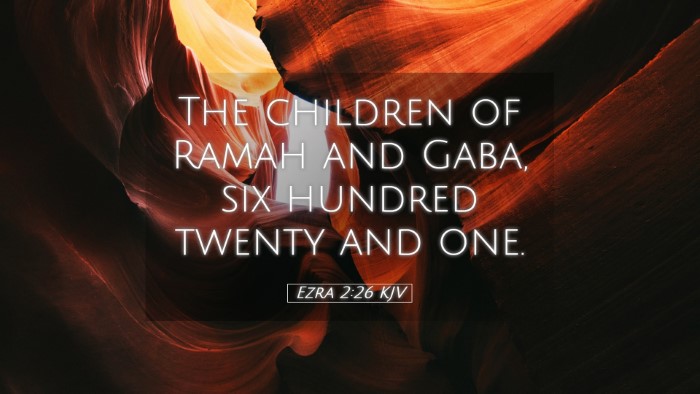Commentary on Ezra 2:26
Ezra 2:26 references the inhabitants of Azmaveth, whose genealogy and status within
the returned exiles is of significant historical and theological interest. This verse serves as a
pivot in the narrative of the return from Babylonian captivity, underscoring the importance of
re-establishing identity and community among the people of Israel.
Contextual Background
The book of Ezra chronicles the return of the Jews from Babylon and their initial efforts in
rebuilding the Temple in Jerusalem. Ezra's role as a scribe and priest is paramount in restoring
the law of God among the people and reinstituting worship. The lists in Ezra 2 serve to validate
the identity of those returning and the continuity of their lineage, which is crucial for the
restoration of both worship and society.
The Significance of Genealogy
Genealogies in the Bible often serve multifaceted purposes. They establish heritage, confirm
promises made by God to His people, and emphasize the faithfulness of God across generations.
Matthew Henry remarks that these genealogical records not only communicate
order within the returning community but also echo the redemptive history that is fulfilled in
Christ. As highlighted in Ezra 2:26, genealogies encapsulate the identity of individuals and
their collective mission following exile.
Insights from Public Domain Commentaries
Matthew Henry's Commentary
Henry emphasizes that the mention of specific families and their numbers reflects God's order
and providence. The children of Azmaveth were part of the restoration process, conveying that
no one is insignificant in the plan God has for His people. Every individual belongs to a
larger story, reaffirming their place in the history of Israel following their return from
captivity. This restoration was not merely about physical buildings but also about renewing
the hearts of the returning exiles.
Albert Barnes' Notes
Barnes underscores that the returnees, including those from Azmaveth, represent the faithfulness
of God's promise to bring His people back to their homeland. The specific naming of families
reflects a commitment to restore true worship and governance in Jerusalem. Each group listed,
including the Azmaveth section, demonstrates a tangible form of national restoration and spiritual
revitalization, emphasizing that the restoration of the Jewish community was vital for the
fulfillment of the covenant.
Adam Clarke's Commentary
Clarke provides an in-depth analysis of the term "Azmaveth," suggesting that it denotes both a
geographical and cultural identity significant to the Jewish people. He points out that the
return from exile involved not only a return to a physical location but also a revival of
community identity and heritage. The inhabitants of Azmaveth would contribute to the overall
rebuilding of Jerusalem, both in a literal and figurative sense, as they re-established their
place in God's unfolding story.
Theological Implications
The role of Azmaveth's descendants in Ezra 2:26 transcends mere historical record; they embody the
deeper theological truths about God's restorative nature. For theologians and scholars, this
passage illustrates the significance of understanding one's heritage in light of divine
providence. The narrative of exile and return provides a framework for exploring themes of sin,
redemption, and the grace of God toward those who stray yet are drawn back to Him.
Pastoral Application
For pastors and spiritual leaders, Ezra 2:26 can serve as a reminder of the importance of community
identities within the church today. Just as the descendants of Azmaveth had roles in the
restoration of Jerusalem, modern congregations are invited to recognize and embrace their
identities in Christ. This verse can inspire churches to prioritize relationships, nurture
ministries that involve diverse backgrounds, and foster a sense of belonging among members.
Ultimately, it reflects the intricate work of God in assembling His people for His purposes.
Conclusion
Ezra 2:26 is a microcosm of the greater themes presented in Scripture surrounding identity,
restoration, and the work of God among His people. The commentary insights from Matthew Henry,
Albert Barnes, and Adam Clarke collectively highlight the historical importance and spiritual
resonance of this passage. For believers today, it serves as a profound reminder of God’s
faithfulness and the vital role of every individual within the body of Christ.


